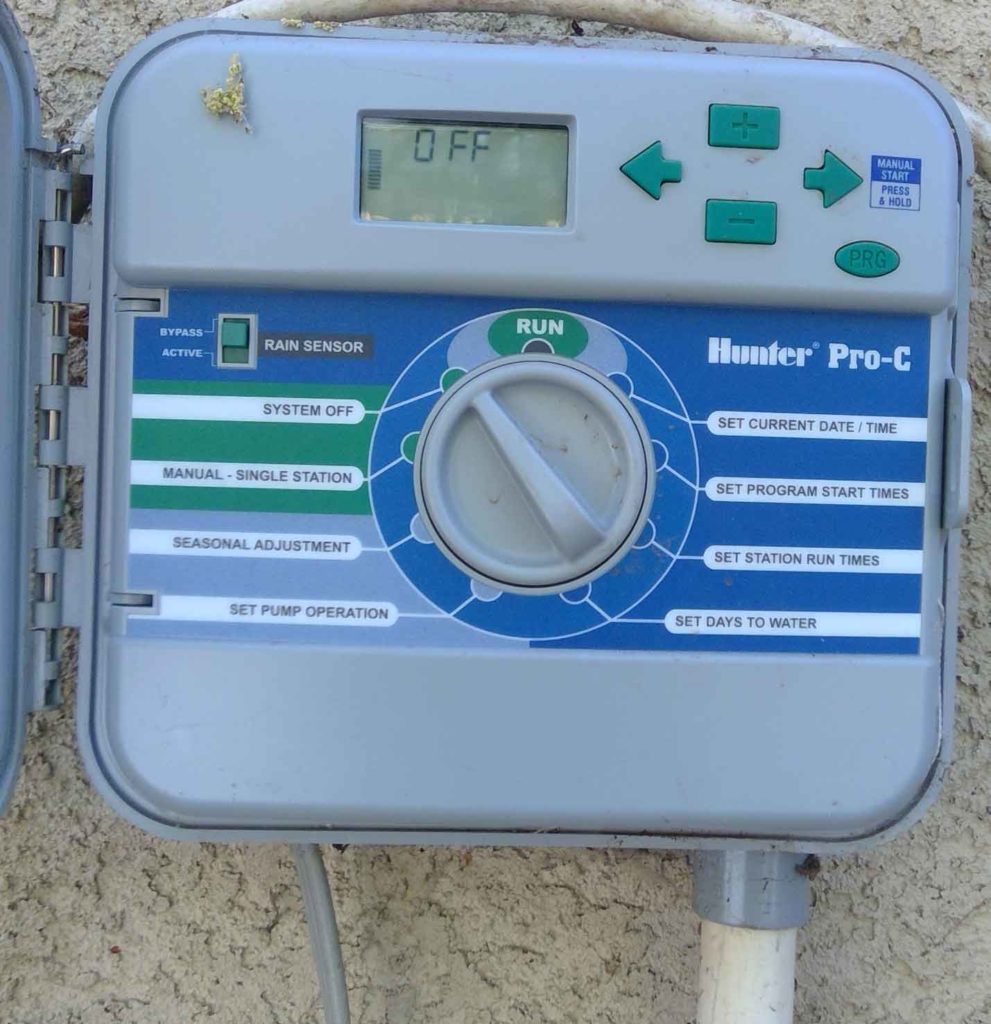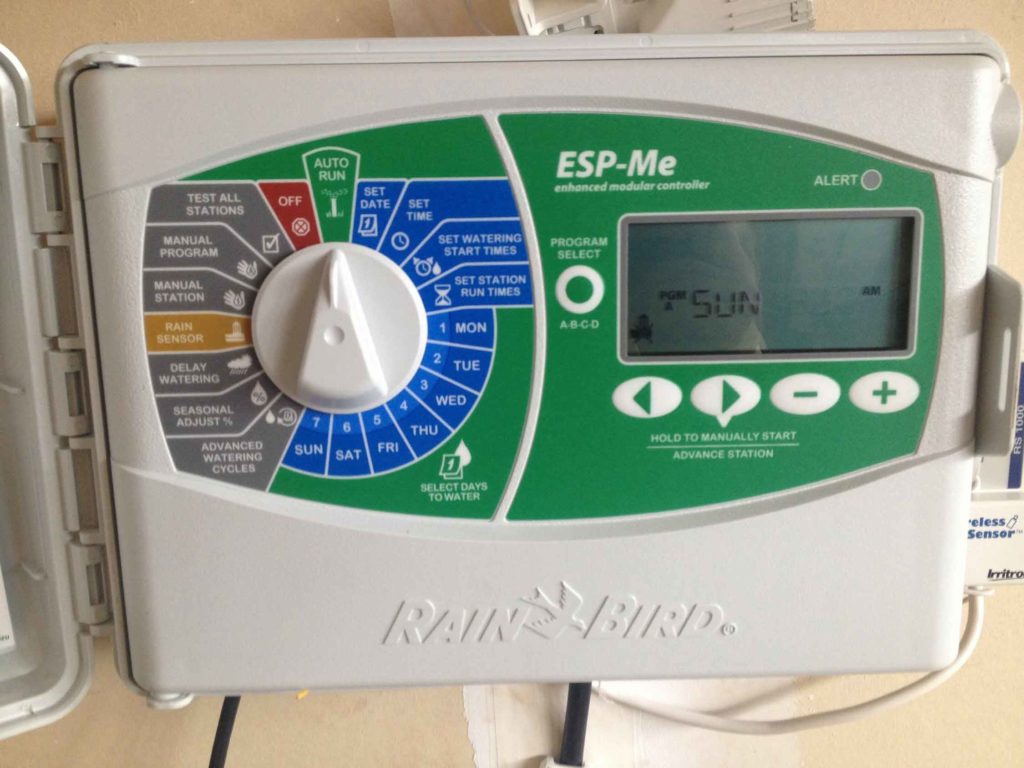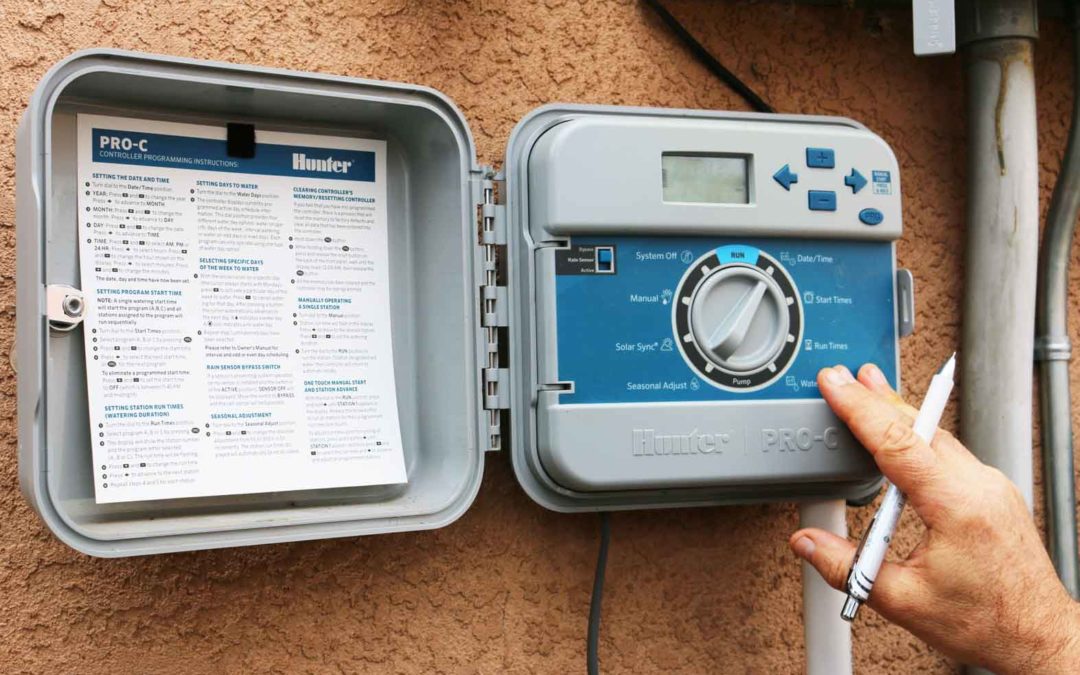Irrigation controllers can be intimidating, particularly because they only get adjusted seasonally and it is easy to forget how to program the timer correctly.
In this article, we are going to explain some terms and point out some functions which are universal, regardless of the type of controller you have. We are also going to provide some pointers on what will help you keep track of it all, as well as provide you with links to a few programming videos that discuss the most common irrigation controllers in Albuquerque. So let’s dig in!
On nearly every controller you will find the following functions: program, time/date, start time, run time, days to water, autorun, and off. You will almost always have some +/- keys and some right and left arrow keys. These +/- and arrow keys are used to set your times and days. Other functions may be included on various timers as well.


Illustrated are two of the most common controllers installed in Albuquerque, the Hunter Pro-C and the Rainbird ESP-Me. They look different at first glance, but a closer inspection shows that they have essentially all the same functions.
What do you need to know to be able to set your controller this spring?
Time/Date: This is an important detail to keep up-to-date so that you are watering at the correct time and on the days that you want to water.
Zone/Station: A zone, or station, is all the sprinklers or drip lines that are controlled by a single valve. You may have one sprinkler valve and one drip valve split between your front and back yard. Each one is a separate zone which means you have two zones.
Program: Programs are how you group your zones that have plants with similar water needs. Using the above example: The lawn sprinkler zone would be selected on Program A. If the drip zone has similar water needs (trees and shrubs) you would group them both on Program B. This is because your lawn (Program A) needs to be watered differently from your trees and shrubs (Program B). If you have an additional zone, like for a vegetable garden, you will put that drip zone in Program C to water differently.
Start Time: It is important to know that the start time applies to the whole Program, not to each zone in a program. Controllers will run zones in succession within a program.
Run Time: This is the amount of time each station, or zone, waters every time it comes on
Example of spring programming:
- Program A starts at 6:00 a.m.and your lawn sprinkler zone runs for eight minutes. Program A, zone 1, will quit watering by 6:08 a,m. If you had more lawn zones, they would water one right after the next.
- Program B, your trees and shrubs zone starts at 10:00 a.m. It runs for 75 minutes so Program B would end watering at 11:15 a.m.
Days to Water: Once again, the days to water apply to all the zones, or stations in one program.
Example of spring programming:
- Program A, your lawn, needs to be watered once or twice a week in the spring so you would set Program A to run twice a week.
- Program B, your trees and shrubs, need to be watered only once a week in the spring so on Saturdays, for example, when you know that you have a better chance of checking the system for issues.
Tips & What to Watch For: Here are some tips to make programming easier and some tips to avoid common mistakes
- Create a seasonal or monthly calendar and hang it up next to your controller.
- Label each zone (Example: Zone 1 – front lawn close to the street)
- Create calendar reminders for yourself, either on your phone or paper calendar, for each season.
- Normally you won’t change the amount of time each zone waters seasonally, just how often you are watering.
- Always double, or triple, check which program and zone you are on when you adjust the settings so you don’t end up setting a lawn zone to water like a drip zone.
- Make sure you are back at Auto/Run whenever you have finished making adjustments. Your controller may not run at all if it isn’t, or it may revert to its emergency programming (usually 10 minutes for every zone, every day).
- Replace your battery back-up every year. You don’t want to reprogram your whole controller if the power goes out.
Links to common controllers found in the Albuquerque area:
Hunter Pro-C: https://youtu.be/pYh-lWXLLRU
Hunter X-Core: https://youtu.be/_PRtho7XiSA
Rainbird ESP-TM2: https://youtu.be/eoNvoVo-Wvs
Rainbird SST: https://youtu.be/pqD8Ew11cC0
Rainbird ESP (older version): https://youtu.be/Amv0s9lzTM4
Toro ECX: https://youtu.be/6rsEWijCxhQ
Toro TMC: https://youtu.be/hE61xXH1BA4
Irritrol Rain Dial: https://youtu.be/9H0u3HK_8QE



